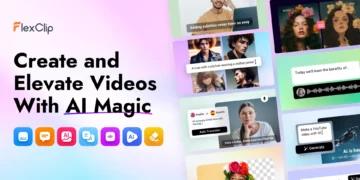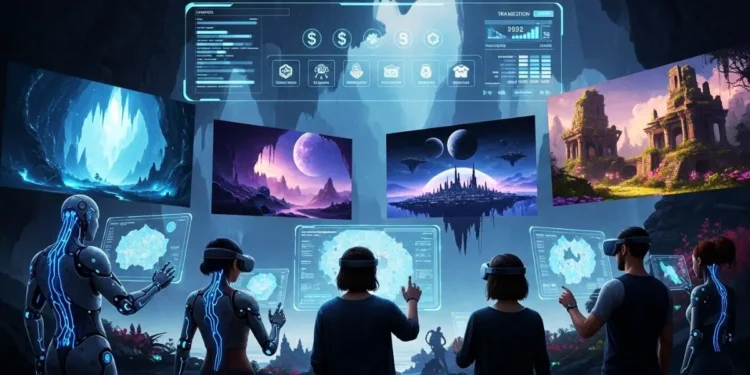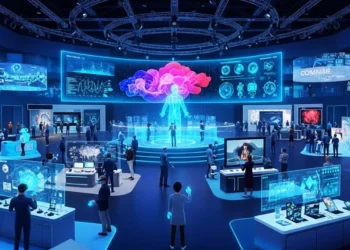Can you imagine doing any of these: looking down at a crater on Mars, strolling along the ruins of Machu Picchu, or diving the Great Barrier Reef? All these are possible now through Virtual Tourights – no joke! Our conventional way of traveling has just been shaken up by a storm called virtual tourism, which completely wipe away cost, limitations of human abilities, and even the harm to nature. Still, does this mean that no one would want to take any real trips? Or maybe the travel industry, by embracing the technology, will be able to extend its reach over new markets, innovate and increase its customer base?
The rise of virtual tourism is nothing less than explosive, with the market expected to reach $23.5 billion in 2028 and an average annual growth rate (CAGR) of 30.2% . The advent of such a novel idea is not aimed at substitution, rather, it is a vehicle for physical travel to be enhanced, accompanied, and extended to those who have no access to the wonders of the world. An undeniably massive opportunity to gain more profits and customer loyalties awaits those who decide to jump on this digital bandwagon: tourism professionals, destination marketers, and entrepreneurs.
Maybe you had such thoughts before that: booking a trip only to find out the place wouldn’t be as great as they say? Virtual tourism is designed to eliminate such worries by giving very lifelike previews that lead to confidence-building. Besides, it is also possible to create brand-new experiences that have no existence in reality. So, let’s start now to understand how this revolutionary technology is transforming traveler’s mindset and paving the way for new monetization opportunities.
What exactly is Virtual Tourism? Beyond the Hype
It is better to have a clear idea of virtual tourism before we start investigating the business potentials. Mainly, it comprises two technological approaches:
Typically, in a tourism Virtual Reality (VR) experience, a totally computer-generated environment can take the whole field of vision. By using a VR headset, you are transported into a 360-degree digitally reconstructed space of a certain place. The content may be real-looking if captured with special omnidirectional cameras or it may be just completely generated by a computer .
Augmented Reality (AR) in tourism, contrary to that, provides you with information in the form of digital media that it inserts into your surroundings in the real world. Through your smartphone, tablet, or AR glasses, you direct your device at a historical place and, in turn, get to see it reconstructed in its perfect original version. Or else you may get navigation arrows superimposed onto the road right in front of you .
Together, these technologies create a spectrum of virtual travel experiences, from complete digital immersion to enhanced real-world exploration.
The Uncharted Territory: Unexplored Destinations in Virtual Tourism
The potential of virtual tourism extends far beyond simple previews of popular destinations. It’s opening up categories of travel that were previously impossible, dangerous, or restricted.
1. Remote and Inaccessible Locations
How can we explore places that are logistically challenging or physically impossible for most people to visit? Virtual reality travel companies are now offering experiences that transport users to the peaks of Mount Everest, the depths of the Mariana Trench, or the surface of Mars. National Geographic’s Explore VR app, for instance, lets users visit Antarctica and Machu Picchu from their homes . This democratizes access to these extreme environments without the associated risks or costs.
2. Historical and Lost Worlds
What if you could travel not just across space, but through time? This is one of the most exciting applications of augmented reality in tourism. Apps like Timelooper and Historik allow users to witness historical events on the very ground they occurred or see historical sites restored to their original splendor . Imagine pointing your phone at the Colosseum in Rome and seeing gladiators battling as it looked in its prime—this is the power of AR to resurrect lost worlds.
3. Fragile Ecosystems and Conservation Areas
Popular natural wonders often suffer from overtourism. VR travel videos of these fragile environments can offer an alternative way for people to experience their beauty without contributing to their degradation. The Golden Gate Park’s JIYU Wild Life app uses AR to provide information about the park’s flora and fauna, fostering responsible tourism and encouraging conservation efforts . This approach allows for unlimited “visitors” without physical impact.
4. Previewing Future Developments
Have you ever wanted to see what a planned resort or development will look like upon completion? Virtual tourism can create previews of destinations that don’t yet exist in their finished form, helping attract investors and future visitors . This application is particularly valuable for real estate development within the tourism sector.
Turning Pixels into Profit: Monetization Opportunities in Virtual Tourism
The business potential of virtual tourism extends far beyond cool tech—it represents substantial monetization opportunities. Let’s explore how forward-thinking virtual reality travel agencies and tourism professionals are generating revenue from digital experiences.
1. Enhanced Virtual Tours and Ticketing
The most direct monetization opportunity comes from premium virtual experiences. While many basic virtual tours are free, tourism operators can create extended, interactive, or exclusive virtual content available through subscription or one-time purchase.
Premium Content: Offer behind-the-scenes tours, expert-led virtual guided tours, or interactive historical reenactments for a fee.
Ticketed Virtual Events: Host virtual festivals, performances, or seasonal events tied to a physical destination. The Coachella music festival app, for example, uses AR to provide interactive maps and performance schedules, a feature that could be monetized .
Bundled Offerings: Combine a virtual preview with a discount on a future physical visit, increasing conversion rates while generating immediate revenue.
Research by Tourism Australia found that VR has the ability to bring a destination to life and make consumers consider travelling to places they wouldn’t have otherwise considered . This makes virtual tours a powerful marketing tool that can pay for itself.
2. Virtual Shopping and E-Commerce Integration
Virtual tourism platforms create perfect opportunities for integrated shopping experiences. When a user is exploring a virtual destination, they can naturally encounter opportunities to purchase related goods.
Digital Marketplaces: Platforms like Smartify’s eShop let users exploring virtual museums buy prints, souvenirs, and gifts directly through the app .
In-App Purchases: Sell digital assets like exclusive tour content, filters, or educational materials within your augmented reality travel app.
Virtual Try-Before-You-Buy: Hotels can use AR to let guests virtually try on branded merchandise like robes or accessories, increasing the likelihood of purchase .
3. Gamification and Interactive Experiences
Gamification represents one of the most engaging monetization opportunities. By incorporating game-like elements into travel experiences, businesses can create new revenue streams while increasing user engagement.
Virtual Treasure Hunts: Apps like Seek Adventure use AR and geolocation to create virtual treasure hunts, encouraging exploration and offering rewards from local businesses .
Educational Games: The Museum of Natural History’s “Skin and Bones” app overlays animated skin and muscles onto skeleton exhibits, making learning interactive and engaging .
Premium Game Features: Offer basic gamified experiences for free while charging for premium features, additional levels, or exclusive content.
4. AR as a Tool to Boost Sales and Conversion
For traditional travel companies, virtual tourism technology serves as a powerful tool to drive bookings and increase customer confidence.
Virtual Previews: Holiday Inn uses augmented reality to offer virtual 360º hotel tours, allowing potential guests to explore rooms and amenities before booking . This builds trust and reduces hesitation.
Reduced Cancellations: When travelers have a realistic expectation of their accommodation through virtual tours, they’re less likely to be disappointed and cancel.
Upselling Opportunities: Hotels can use AR to showcase room upgrades, spa treatments, or dining experiences, visualizing the premium offering and justifying the additional cost .
Snapchat found that users expect to spend more when AR is part of their travel planning journey because it helps them be more confident in their decisions .
5. Subscription Models and Premium Apps
While many basic AR navigation and translation apps are free, there is growing potential for premium subscription-based models in the virtual tourism space.
Ad-Free Experiences: Offer an enhanced, uninterrupted experience for a monthly or annual fee.
Exclusive Content: Provide access to rare destinations, expert commentary, or specialized tours only available to subscribers.
Advanced Features: Reserve features like offline access, high-resolution downloads, or family sharing for paying customers.
Augmented Reality in Tourism: Enhancing the Physical World
While VR creates entirely new digital worlds, Augmented Reality (AR) enhances our existing one by overlaying digital information onto our real-world view through a smartphone or smart glasses. This technology turns every trip into an interactive, informative, and engaging adventure.
An augmented reality travel app can transform a simple city walk into a journey through time. Point your phone at the ruins of the Roman Forum, and an AR app can show you a 3D reconstruction of how it looked centuries ago. In a museum, you can scan an artifact to see an animation of its use or watch a historical figure come to life to tell their story.
Augmented Reality Tourism Examples in Action
The applications for AR in travel are vast and growing. Here are a few powerful augmented reality tourism examples:
Interactive Navigation: Apps like AR City provide directional arrows and points of interest overlaid on your screen, making it nearly impossible to get lost in a new city.
Historical Recreations: In places like Pompeii or the Colosseum, tourists can use AR to see ancient buildings and streets restored to their former glory, providing a rich historical context that photos can’t match.
Gamified Tours: Cities and attractions are using gamification to engage visitors, creating AR-powered scavenger hunts or quizzes that make exploring fun for all ages.
Museum Enhancements: The Kennedy Space Center’s “Heroes and Legends” exhibit uses AR to let visitors experience historical events in 3D, making the information more memorable and impactful.
For those interested in a deeper dive, many universities and research firms publish detailed reports, often available as an augmented reality in tourism PDF, which explore the technology’s impact and potential.
Top Tips for Using AR in Tourism
Ready to integrate AR into your tourism strategy? Focusing on the user experience is key. Here are four top tips for using AR in tourism to create unforgettable moments.
Make it Interactive and Fun: Don’t just display information—make it an experience. Use gamification, 3D animations, and interactive models. For instance, an AR app at a medieval exhibit could trigger a virtual duel between two knights, bringing the armor on display to life.
Solve a Real Problem: The best AR applications are practical. Use AR for real-time language translation of signs and menus, to display transportation schedules when a user looks at a bus stop, or to offer interactive directions inside a large airport or hotel.
Bring Stories to Life: Use AR to tell the stories behind the landmarks. Recreate historical events, show how a landscape has changed over time, or have a virtual guide share interesting facts as tourists explore. This transforms a passive viewing into an active learning experience.
Enhance the Booking Process: AR isn’t just for the trip itself. Hotels can use AR to let potential guests place a virtual model of a hotel room in their own home to get a sense of the space. Travel companies can create AR-enhanced brochures that come to life with videos and 3D models when scanned.
Solve Real Problems, Don’t Just Add Tech: The most successful augmented reality tourism examples address genuine traveler pain points. Whether it’s navigation in a foreign city with an app like Citymapper , breaking language barriers with Google Translate , or providing historical context at a ruins site, your AR solution should have a clear purpose that enhances the travel experience.
Focus on Content Quality and Storytelling: The technology is just a vessel; the content is what creates the magic. Invest in high-quality 3D models, accurate historical information, and compelling narratives. As seen with the “Rebuilding Notre Dame” VR experience, powerful storytelling creates emotional connections that travelers remember long after the trip .
Ensure Accessibility and Ease of Use: The best augmented reality travel app is one that people can actually use. Since most travelers already carry smartphones, focus on mobile-first solutions that don’t require specialized hardware. Ensure your app is intuitive, with a low learning curve, so it enhances rather than complicates the travel experience.
Integrate with the Physical Experience: AR should complement and enrich the real world, not distract from it. The British Museum’s “A Gift for Athena” app is a perfect augmented reality tourism example—it provides additional layers of information about existing exhibits, deepening engagement with the physical artifacts .
The Future of Virtual Tourism: What’s Next?
Monetizing the Virtual World: The Business of Digital Exploration
The rise of virtual and augmented tourism has created a thriving ecosystem of new business opportunities. From content creation to curated digital travel, the monetization possibilities are vast.
Virtual Reality Travel Companies and Agencies
A new breed of virtual reality travel companies has emerged to meet the growing demand for immersive content. Companies like Travel World VR and Virtually Visiting specialize in producing high-quality VR travel videos and 360-degree experiences for destinations, hotels, and tour operators. These companies handle everything from filming with specialized 8K 3D cameras to developing custom apps, offering a full suite of services to bring virtual travel to the masses.
This has also given rise to the virtual reality travel agency model. These agencies curate and sell virtual travel packages, allowing users to purchase access to exclusive tours, guided virtual hikes, or immersive cultural experiences. It’s a powerful way to generate revenue, reach a global audience, and provide accessible travel options for those with limited mobility.
Four Top Tips for Using AR in Tourism Successfully
Implementing augmented reality in tourism effectively requires strategy, not just technology. Here are four top tips for using AR in tourism to ensure your initiative delivers real value:
Solve Real Problems, Don’t Just Add Tech: The most successful augmented reality tourism examples address genuine traveler pain points. Whether it’s navigation in a foreign city with an app like Citymapper , breaking language barriers with Google Translate , or providing historical context at a ruins site, your AR solution should have a clear purpose that enhances the travel experience.
Focus on Content Quality and Storytelling: The technology is just a vessel; the content is what creates the magic. Invest in high-quality 3D models, accurate historical information, and compelling narratives. As seen with the “Rebuilding Notre Dame” VR experience, powerful storytelling creates emotional connections that travelers remember long after the trip .
Ensure Accessibility and Ease of Use: The best augmented reality travel app is one that people can actually use. Since most travelers already carry smartphones, focus on mobile-first solutions that don’t require specialized hardware. Ensure your app is intuitive, with a low learning curve, so it enhances rather than complicates the travel experience.
Integrate with the Physical Experience: AR should complement and enrich the real world, not distract from it. The British Museum’s “A Gift for Athena” app is a perfect augmented reality tourism example—it provides additional layers of information about existing exhibits, deepening engagement with the physical artifacts .
The Future of Virtual Tourism: What’s Next?
The virtual tourism landscape is evolving rapidly, driven by advancements in both hardware and software. Here’s what we can expect in the coming years:
More Realistic Experiences: As VR headsets like Apple Vision Pro and Meta Quest 3 become more advanced and widespread, the resolution and realism of VR travel videos will become increasingly photorealistic .
AI-Powered Personalization: Artificial Intelligence will enable hyper-personalized virtual travel guides that adapt to user interests in real-time, creating unique itineraries and narratives for each traveler .
Social and Shared Experiences: Future platforms will focus on shared virtual spaces where friends and family can explore digital destinations together, regardless of their physical locations.
Hybrid Travel Models: We’ll see the rise of blended experiences where virtual previews seamlessly transition into physical travel, with AR enhancement throughout the journey.
Conclusion
Virtual tourism is a different concept to physical travel; basically, it is an expansion of the travel idea. The barriers which were an impediment in the past are taken away, experiences are improved, endangered places are saved, and there are new and very exciting ways that the industry can be monetized as a result. One potential that is only constrained by our creative power is the use of augmented reality by museums so that the exhibits can be more engaging. To sum up, the possibilities are endless from immersive previews provided by a virtual reality travel agency to AR used by museums to make the exhibits more engaging.
The market is reaching a new high beyond what has been seen before, and those who are quick to adapt will be able to enjoy the benefits of a significant competitive advantage. The decision to delve into the world of virtual tourism is an unequivocal yes for you if you work as a destination marketer, are a hotel owner, a tour operator, or a travel entrepreneur. How can you and your business benefit from virtual tourism? The answer is simple; it’s the right time for you to realize its potential.
Then, in this case, what would be your first destination in the virtual world? What methods would you employ to harness these technological advances to render such experiences for your audience that they would never forget, while at the same time, you would be building a sustainable and profitable business future? The voyage towards virtual tourism is at its inception, and the possibilities could be as wide as the digital horizon.
Frequently Asked Questions (FAQs)
What are some compelling augmented reality tourism examples?
Several innovative applications demonstrate AR’s potential in tourism. The British Museum uses an AR app called “A Gift for Athena” to provide interactive experiences with exhibits . Google Lens offers real-time translation of foreign text, making navigation easier . Apps like Timelooper recreate historical events at famous locations, while others like AR City Tours offer guided tours where pointing your phone at a building reveals its history .
Where can I find research on augmented reality in tourism in PDF format?
Academic research on this topic is often available through platforms like Academia.edu, which hosts papers such as “Augmented Reality Applications in Tourism” that analyze case studies across various tourism sectors . Additionally, research portals like ScienceDirect publish peer-reviewed studies on the subject, including contextualized studies on AR usage in the tourism industry .
How is virtual reality different from augmented reality in tourism?
Virtual Reality (VR) fully immerses users in a digital environment, replacing their real-world surroundings, ideal for virtual tours of distant locations or historical recreations . Augmented Reality (AR) overlays digital information onto the real world, enhancing rather than replacing your actual environment—perfect for navigation, translation, and enriching physical sites with additional context . Think of VR as transporting you somewhere else, while AR enhances where you already are.
What should I look for in a virtual reality travel agency?
When evaluating virtual reality travel companies, look for those offering high-quality, immersive content (both monoscopic for mobile and stereoscopic for headsets) . They should provide diverse destinations and experiences, and have a strong track record in the travel industry. Companies like Immersion VR specialize in creating 360-degree content specifically for tourism marketing and virtual experiences .
How can I create effective VR travel videos?
Effective VR travel videos should be photorealistic, optimized for smooth performance across devices, interactive, and narrative-driven to maintain engagement . They are typically captured using specialist omnidirectional cameras that film every angle, with the footage then “stitched” together to produce an immersive 360-degree experience .
What are the key features of a successful augmented reality travel app?
A successful augmented reality travel app should solve real traveler pain points, such as navigation, translation, or education. It must be user-friendly, with intuitive controls, and offer high-quality, accurate content. Successful examples like Google Maps’ Live View and Yelp Monocle provide immediate value by helping users find their way or discover local restaurants through their smartphone camera .







































